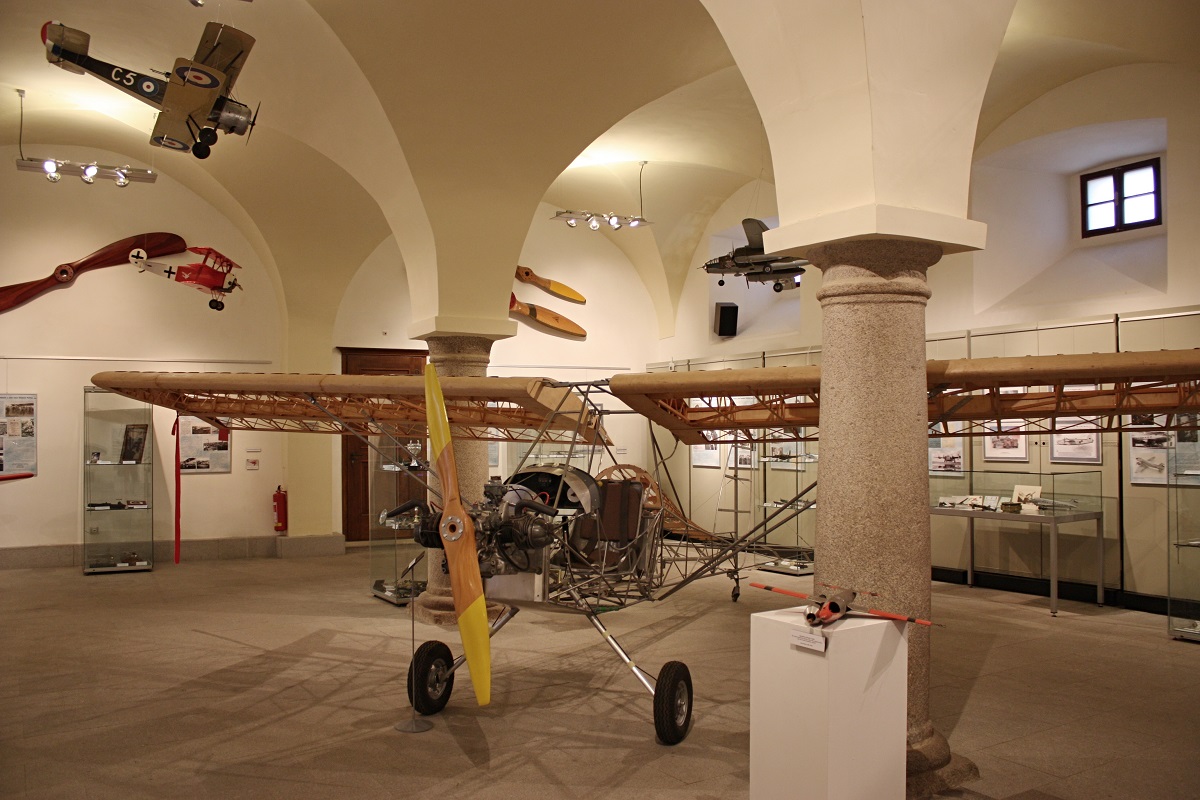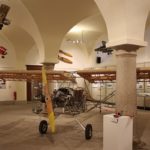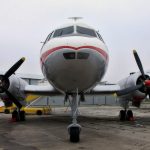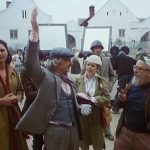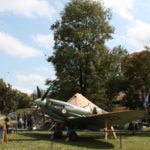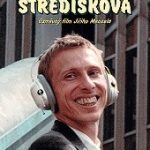In the Třebíč chateau with the adjoining basilica of St. Prokop was recently opened an exhibition entitled Air is our sea-100 years of aviation in the Třebíč region. Outdoors was a beautiful weather and, moreover, a national holiday, I did not resist and visited this exposition. Every visitor learns not only about the diverse military and civil aviation history of this micro region, but also about the long tradition of Třebíč modellers, or about the stories of people who have not come to terms with normalization in communist Czechoslovakia and have tried to leave it. Numerous original artifacts, aircraft models, real-time flying machines, home-made machines, billboards, and the possibility of buying a catalog are complemented by four thematic accompanying events.
Considering that the invention of the aircraft was primarily used by the army, it is no wonder that the first local aviators were Augustin Slavík and František Netolička serving in the Austro-Hungarian Air Force. The first mentioned aviator performed 46 combat flights during the First World War and also participated in a bomber raid on the Porta Volta power plant in Milan. On the Italian front at the Field Regiment No. 14, Jaroslav Herzán was also briefly acting (then Commander marching and pedestrian field company) as an air observer. To capture the positions, bases and movements of the enemy in the mountainous terrain, he was appointed due to his numerous injuries from previous battles. It is interesting that his military servant was František Václav Süsser, one of the most important post-war Brno painters and a close friend of the artist Oskar Kokoschka.
The inter-war period and the growing popularity of the air days for Třebíčsko in the exhibition is more often documented as a stage of frequent accidents of the warships. Equally tragic fate 6 September 1931 demonstration and pilot Václav Peřina. In the showcase with objects reminding in different ways this event is also possible to read the original accident report, which talks about three sudden losses of machine height. Two were able to cope with the airplanes, unfortunately during the last one he died. Fate, however, he wanted to be born in February 1930 in the sky of Cheb, a star that had to end this sad statistics definitively. It was Petr Široký, a member of the legendary trio of acrobatic pilots Novák-Široký-Hubáček. His successes include, for example, a second place in solo acrobatics at an international aviation race in August 1936 held in Rangsdorf.
I continue my tour of the Second World War and brave natives serving at the RAF in various professions. Nearly three dozen men have been documented about which they know, but of course they could have been much more. Among the most well-known names are Stanislav Huňáček, Emanuel Krajina, Jindřich Svoboda or Stanislav Rejthar. In April 1948, Huňáček as a CSA pilot managed to fly with Dakota to Munich. He spent the rest of his life in northeast Aglia. However, the men who were trained in other specialties were also famous. Of many, let’s say at least the 311th sq. and radar operator 68. sq. Bedřich Kružík, mechanics 311. sq. Josef Macháček or the rear shooter and cabin mechanic Karel Nahodil. Part of this part of the exhibition includes artifacts from collapsed aircraft or remnants of bombs found around the Association of Aviation History Třebíč.
The post-war boom of sport flying brought fresh wind to this region and it did not take long, and the first aero club and the Aircraft Modeling Association were established with the warm support of Třebíč. In the February coup, hundreds of members of the Aeroclub managed to organize two air flights thanks to friendly relations with other aeronautical clubs. Unfortunately, the events of the following days and years have completely ended its existence. The machines were taken by the remaining members to the airport in Křižanov, where they continued to operate. It was not until 1991 that the Aeroclub was restored thanks to the great effort of Karel Picmaus, the powder-handling pilot, who was also president for the next seven years. To date, the club has managed to raise several successful representatives from various fields of flying. They include names such as Ladislav Teplý, Ondřej Šilhan or Martin Dalajka. The cups from domestic and foreign competitions displayed in the showcase are, in fact, clear evidence.
Their story has even the biggest exhibits here. The frame of a one-seat ultra-light airplane of mixed construction (all-wood wings, the fuselage is a thin-walled steel tube weldment), dominated by the entire exhibition at the event was lent by the current owner, the technical museum Alternator in Třebíč-Borovina. The machine for the original owner Stanislav Vršek was designed by the pilot and designer Petr Mára in 2005, while a modified engine from Trabant was selected as a sufficient drive unit. In the same year three more specimens were built in Třebíč. However, only two were completed, the exposed plane was made out of 3/4 and the last piece was not preserved. On the right hand side is a home-made hot air balloon. He wanted to try to escape beyond the borders of Jiří Runkas and his family in the early eighties. The body of the aerostat was sewed by a woman from a rubberized jerk and the basket itself was knitted by a local basketball player. Thanks to the anonymous statement shortly before the date of departure, the attempt to leave the Republic did not materialize.
The previously mentioned modeling association fortunately in 1948 did not die and works successfully today. In the past, his members presented their models on aviation days, exhibitions and won many home competitions with them. At present, the club has two masters of Europe, Karel Ošmer and Pavel Bárta. There are several thematic and flightable models, including historical models of various types (pulsatile or radio-controlled). In the eighties, a free-time activity industry was also added to the club of plastic modellers operating under the name of Třebíč Nuclear Model Club, which at the same time largely participated in the creation of this exhibition. Their airplane models are largely and thematically well suited to specific stages of local aviation development.
Finally, I would like to share your personal feelings with the show. I was very pleasantly surprised by her carefully prepared and well-designed work, and although she was reserved for only one room, I think the authors did their best to fill them with no rest. Personally I can recommend the exposition as an excellent and educational tip for a family trip.
source:
BARTL, František, Jaroslav BAŠTA, Pavel BEROUN, et al. Vzduch je naše moře: 100 let letectví na Třebíčsku : katalog k výstavě v Muzeu Vysočiny Třebíč, 29. června - 14. října 2018. Třebíč: Muzeum Vysočiny Třebíč, 2018. ISBN 978-80-86894-48-5.

